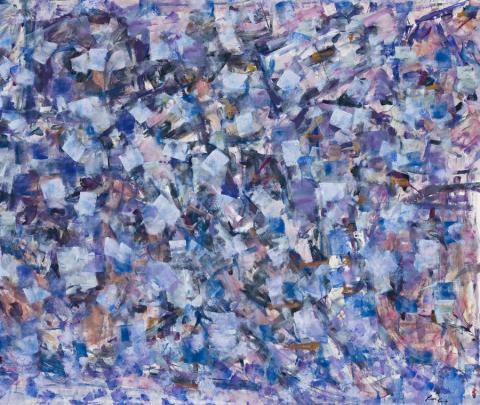UNTITLED, c.1970-75
Roger Kemp
synthetic polymer paint on paper on canvas
147.5 x 174.0 cm
signed lower right: Roger Kemp, inscribed upper left: (illeg.)
Private collection, Melbourne
Deutscher~Menzies, Melbourne, 27 November 2002, lot 26
Private collection, Melbourne
In the late 1960s, when Roger Kemp turned to painting on large sheets of paper, his style underwent a new breadth and freedom of expression. His paintings were larger than anything he had tried before. Moreover, the use of water based synthetic polymer paint was more suited to the smoother surfaces of paper than those of the previous hardboard. It allowed more fluid application of paint and subtler nuances of colour, as seen in this very fine painting. As Patrick McCaughey wrote in 1970, 'Colour could now be laid onto the surface as a washed area, no longer subservient to structural purpose.'1 Edges were softer, and colours floated in their own illusions of depth, as well as across the picture plane. Delicate of hue, the palette of blues and pale reds morphed into imperial purples invoking contemplation within the infinite variety of forms, still but moving. While this enabled a new emphasis on the brushstroke, there is complete harmony between technique and conception. The absence of the specific title, which tends to lead the viewer in a set direction, encouraged the appreciation of the painting in its own right, one of the profound pleasures to be enjoyed in looking at his abstract art.
Kemp's paintings on paper had their first public showing in the 1975 at the University of Melbourne's exhibition, Roger Kemp on Paper. It included those of his more exactly defined geometric forms, especially of circles and squares, as well as works like this one - allied more to water in their fluidity. Of transparency, they are likewise akin to water, balanced between what you can see through it, yet resistant. Such paradoxes enable perception to free itself from the material and move into the mystical, superseding that of the merely physical and rational. In other words, Kemp takes us into dimensions of his own perception, of explorations of the universal and infinite in his pursuit of enlightenment. In his introduction to an exhibition of Kemp's complete etchings, Hendrik Kolenberg wrote, 'He was not producing an image of the visible world. His was a cosmic, philosophical vision, man as part of an infinitely varied universe. His visual language, his vision, is perhaps closest to those of the twentieth century science - the study of space and time, or life as seen under a microscope.'2 Connoisseurs of Australian art rightly rank Kemp's large works on paper among the best of painterly abstraction, equal to those of Ian Fairweather.
1. McCaughey, P., 'Roger Kemp', Art and Australia, Ure Smith, Sydney, vol.8, no.2, September 1970, p. 154
2. Kolenberg, H., Roger Kemp, the complete etchings, Art Gallery of New South Wales, Sydney, 1991, p. 13
DAVID THOMAS
